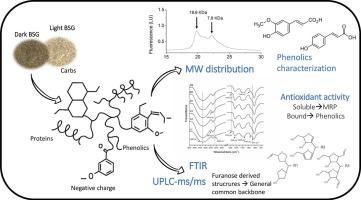Interaction between Maillard reaction products and phenolics in brewer's spent grain: Structural and antioxidant insights
IF 8
1区 农林科学
Q1 FOOD SCIENCE & TECHNOLOGY
引用次数: 0
Abstract
Brewers' spent grain (BSG), the main lignocellulosic by-product of the brewing industry, has attracted increasing interest as a sustainable source of bioactive compounds, particularly phenolics and Maillard reaction products (MRP) such as melanoidins. Despite their health-related properties, the structural features and mechanisms underlying the bioactivity of BSG-derived melanoidins remain poorly understood. Therefore, the present study investigated the structure of melanoidins from light and dark BSG and their interactions with phenolic compounds. Dark BSG exhibited a higher degree of Maillard reaction development, though melanoidins from both types showed major molecular weight peaks at ∼19.3 and 7.9 kDa. High molecular weight melanoidins (>12 kDa) were mainly composed of carbohydrates and proteins, with 4.1–6.7 % phenolics a negative surface charge (−23.77 to −38.7 mV) and antioxidant activity. FTIR analysis revealed α-glycosidic and proteinaceous structures, the latter partially degraded by roasting. UPLC-MS/MS identified furanose-derived MR markers present in comparable proportions in the melanoidins from both light and dark BSG. Besides, results suggest that phenolics, such as ferulic acid, were covalently bound to the melanoidin matrix. Finally, the antioxidant activity of the soluble BSG fraction was associated with the presence of Maillard products, while the antioxidant capacity of the bound fraction was better related to the phenolics of BSG. Overall, these findings highlight the structural role of phenolics in modulating melanoidin properties and their contribution to antioxidant potential. Moreover, these findings provide new insights into the structural interactions between MRP and phenolics and may guide the development of improved analytical approaches for studying melanoidin–phenolic complexes.

美拉德反应产物与啤酒废谷物中酚类物质之间的相互作用:结构和抗氧化的见解
酿酒者的废谷物(BSG)是酿酒工业的主要木质纤维素副产品,作为生物活性化合物的可持续来源,特别是酚类物质和美拉德反应产物(MRP),如类黑素,引起了越来越多的兴趣。尽管它们具有与健康相关的特性,但bsg衍生的类黑素的结构特征和生物活性背后的机制仍然知之甚少。因此,本研究研究了浅色和深色BSG中类黑素的结构及其与酚类化合物的相互作用。深色BSG表现出更高程度的美拉德反应发展,尽管两种类型的类黑素的主要分子量峰分别为~ 19.3和7.9 kDa。高分子量类黑素(12 kDa)主要由碳水化合物和蛋白质组成,含有4.1 - 6.7%的酚类物质,表面负电荷(- 23.77 ~ - 38.7 mV),具有抗氧化活性。FTIR分析显示α-糖苷和蛋白质结构,后者经焙烧部分降解。UPLC-MS/MS鉴定了在浅色和深色BSG的类黑素中以相当比例存在的呋喃糖衍生的MR标记。此外,结果表明酚类物质,如阿魏酸,与类黑素基质共价结合。最后,可溶性BSG馏分的抗氧化活性与美拉德产物的存在有关,而结合馏分的抗氧化能力与BSG的酚类物质有关。总的来说,这些发现强调了酚类物质在调节类黑素性质中的结构作用及其对抗氧化潜力的贡献。此外,这些发现为MRP与酚类物质之间的结构相互作用提供了新的见解,并可能指导研究类黑素-酚类复合物的改进分析方法的发展。
本文章由计算机程序翻译,如有差异,请以英文原文为准。
求助全文
约1分钟内获得全文
求助全文
来源期刊

Food Research International
工程技术-食品科技
CiteScore
12.50
自引率
7.40%
发文量
1183
审稿时长
79 days
期刊介绍:
Food Research International serves as a rapid dissemination platform for significant and impactful research in food science, technology, engineering, and nutrition. The journal focuses on publishing novel, high-quality, and high-impact review papers, original research papers, and letters to the editors across various disciplines in the science and technology of food. Additionally, it follows a policy of publishing special issues on topical and emergent subjects in food research or related areas. Selected, peer-reviewed papers from scientific meetings, workshops, and conferences on the science, technology, and engineering of foods are also featured in special issues.
 求助内容:
求助内容: 应助结果提醒方式:
应助结果提醒方式:


